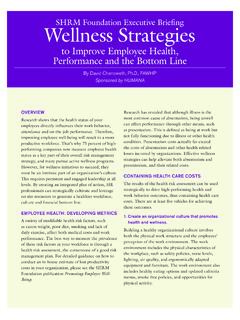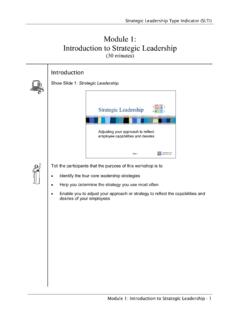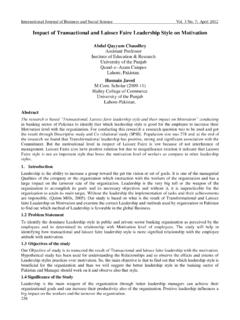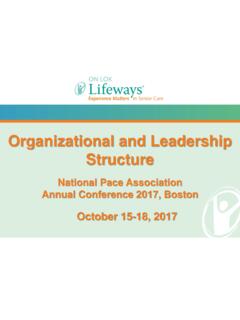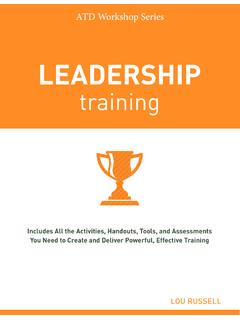Transcription of A Literature Review of Employee Engagement
1 Running head: Literature Review OF Employee Engagement 1 A Literature Review of Employee Engagement William E. Garlick III Siena Heights University Literature Review OF Employee Engagement 2 A Literature Review of Employee Engagement Over the last two decades, the organization Gallup has been conducting a survey to gauge overall Employee Engagement . They have accomplished this through a list of 12 questions in their G12 Employee Engagement survey that identifies the percentages of employees that fall into one of three groups: employees that are (a) engaged, (b) not engaged, and (c) actively disengaged.
2 ("Gallup G12 Survey", ). Engaged The group of engaged employees are highly committed to the organization, show a passion, and drive in their work (Sorenson & Garman, 2013). They strive for excellence in their roles (Anitha, 2014). Not Engaged The group of not engaged employees are just going through the motions at work. Overall, they lack a drive and passion for the work they do (Sorenson & Garman, 2013). Employees who are not engaged focus on the tasks given to them instead of the mission of the organization (Anitha, 2014). Actively Disengaged Actively disengaged employees are not just unhappy at work; they are acting out in ways that show their unhappiness (Sorenson & Garman, 2013).
3 They tend to demotivate other employees in the organization who might fall in the engaged category (Anitha, 2014). Current State of Engagement The survey data collected by Gallup during 2014 of US companies showed that of employees were engaged , were not engaged , and were actively disengaged (Adkins, 2015). Nearly 70% of all employees are not committed to the organization and lack a Literature Review OF Employee Engagement 3 level of enthusiasm for work. The implications of this can be staggering when you consider the possibilities of engaging even a small portion of disengaged population.
4 Changes in Engagement have the potential to affect the employees, the organization, and the customers. Organizations faced with this stark reality can no longer choose to do nothing about this issue. Leaders need to seek out information about Employee Engagement and begin to transform their organizations from the current reality of disengagement to a future hope of Engagement . It is to that end that this Literature Review exists. Outline This paper will focus on qualitative and quantitative analysis performed on the topic of Employee Engagement from studies published over the last five to six years with a specific focus on the following research questions: To what degree do various factors have on Engagement ?
5 To what degree does Engagement have on various outcomes? What are the practical implications from research studies for improving Engagement ? Literature Review Antecedents of Engagement Career growth. Research suggests that both training and career development are a driver of Employee Engagement . Training directly improves job performance, which leads to the Employee having more confidence in their ability, which directly relates to job Engagement . The development of an Employee s career also improves their Engagement (Anitha, 2014). Karatepe (2013) suggests that training and empowerment lead to high performance work practices through greater Employee Engagement .
6 Literature Review OF Employee Engagement 4 Compensation. Rewards and recognition of both formal and informal varieties are significant factors in Employee Engagement (Anitha, 2014). Organizations typically have financial rewards available to employees but research has shown that it is also vitally important to offer psychological rewards such as recognition and encouragement, or customer feedback on a frequent basis as well. Recognition and rewards increase job satisfaction and Engagement (Hofmans, Gieter, & Pepermans, 2013). leadership . Wallace and Trinka (2009) identified leadership activities such as coaching, career development, and communication of purpose, naturally resulted in greater Employee Engagement .
7 Most employees want to be engaged at work and it is the leader s responsibility to assist the Employee in doing so. The research conducted by Xu and Thomas (2011) indicate strong correlations between Employee Engagement and the leader s ability to support and develop the team. They also suggest that leaders can encourage Engagement through task-oriented behaviors such as good decision-making, ethical behavior , and task management. Research has also suggested that leaders can enhance the likelihood of Engagement by talking to their employees about their needs.
8 When this was done at one company, the leaders were then able to adjust schedules to match their Employee s needs and as a result increased Engagement (Schneider, Macey, & Barbera, 2009). Hansen, Byrne and Kiersh (2014) studied the relationship between interpersonal leadership and Engagement and found that interpersonal leadership is positively associated with Employee Engagement . The research also showed that leaders who exhibited positive interpersonal leadership traits provided environments in which employees could thrive. Wellbeing. Research done by Robertson and Cooper (Robertson & Cooper, 2010) indicated a positive link between Employee Engagement and psychological wellbeing.
9 Literature Review OF Employee Engagement 5 Individuals with a higher level of wellbeing not only benefits the organizational performance but those employees behave differently which lead to a higher level of Engagement . Spirituality. Research conducted by Roof (2015) on the previously unexplored relationship between spirituality and Engagement showed that spirituality had both a positive and significant correlation with Engagement . Spirituality is positively related to the factors of Engagement of vigor and dedication, but not with absorption based on his research.
10 Relationships. Recently research done on the effects of positive relationships at work confirmed existing findings that there is a strong correlation on Employee satisfaction and Engagement with employees who have positive relationships in the work place (Glinkska-Newes, 2014). The researcher found that employees with positive relationships with their workmates demonstrate higher performance, commitment and satisfaction (Glinkska-Newes, 2014, p. 641). Organizational structure. According to AbuKhalifeh and Som (2013), the Chartered Institute of Personnel and Development survey indicates that both upward communication and knowledge of the organizational changes are key factors in Engagement .
